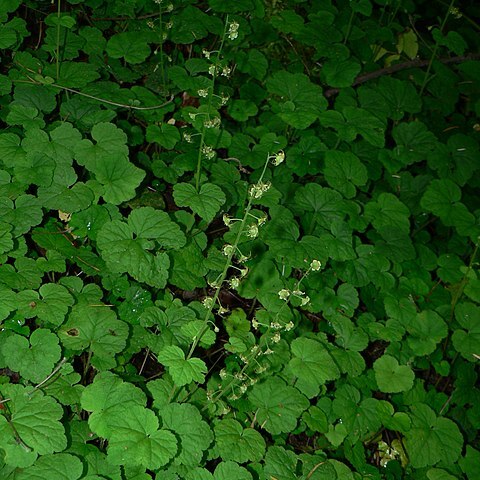Herbs, rhizomatous, stoloniferous or not; caudex not cormlike, usually with persistent leaf bases. Flowering stems ascending or erect, leafy or leafless, (2-)6-55(-65) cm, subglabrous or short to long stipitate-glandular. Leaves in basal rosette and cauline; cauline leaves absent or 1-3, alternate or opposite; stipules present; petiole present, sometimes absent in cauline leaves, subglabrous or stipitate-glandular; blade ovate, cordate, or reniform, usually shallowly lobed, rarely unlobed, base cordate to truncate, margins crenate to dentate, apex acute, obtuse, or rounded, surfaces glabrous or subglabrous to variously stipitate-glandular; venation palmate. Inflorescences racemes, terminal from axillary buds in rosette, (scapose or leafy, anthesis usually acropetalous, basipetalous in M. caulescens, not secund to weakly secund or, rarely, strongly secund), 2-60-flowered, sometimes flowers solitary, bracteolate. Flowers: hypanthium adnate ± entire length of ovary, free from ovary to 1.5 mm, green, greenish white, or greenish yellow; sepals 5, white, greenish white, greenish, yellowish green, or greenish yellow, sometimes purple tinged; petals 5, greenish, greenish yellow, whitish green, or white, sometimes pink or purple tinged, (claw slender); nectariferous tissue proximal to stamens absent or obscure; stamens 5 or 10, opposite or alternate with sepals; filaments filiform; ovary nearly superior to nearly completely inferior, 1-locular, (2-lobed), carpels connate ± entire length, (equal); placentation parietal; styles 2; stigmas 2. Capsules obscurely 2-beaked, (dehiscent by adaxial sutures on free, lobed portion, dehiscent fruit sometimes appearing almost circumscissile). Seeds (4-40), reddish purple, dark reddish brown, or blackish, shiny, ellipsoid to ovoid, nearly smooth or pitted. x = 7.
More
Herbs perennial. Rhizomes creeping, short. Leaves mainly basal, long petiolate, cauline ones few or absent; stipules scarious; leaf blade simple, cordate or ovate-to reniform-cordate, margin lobed or incised. Inflorescence terminal, racemose, bracteate. Flowers small. Sepals 5. Petals sometimes absent, margin usually pinnately cleft, rarely entire. Stamens 5 or 10. Carpels 2, connate; ovary appearing subsuperior to inferior, 1-loculed; placentas 2, parietal; styles 2. Fruit a capsule, dehiscing between styles. Seeds numerous, ovoid or narrowly ellipsoid, usually tuberculate.
Fls perfect, regular, perigynous, 5-merous; hypanthium turbinate to saucer-shaped, adnate to the base of the carpels; pet narrow, deeply pinnatifid or fimbriate to entire; stamens 10 (in ours) or 5; carpels 2, connate into a 2-beaked, unilocular, superior (to half-inferior) ovary with low-parietal placentas; rhizomatous herbs with basal or alternate, palmately veined lvs from the rhizome, the flowering stems lfless or nearly so, with a terminal bracteate raceme of small white, greenish, or purple fls. 12, N. Amer., e. Asia.

